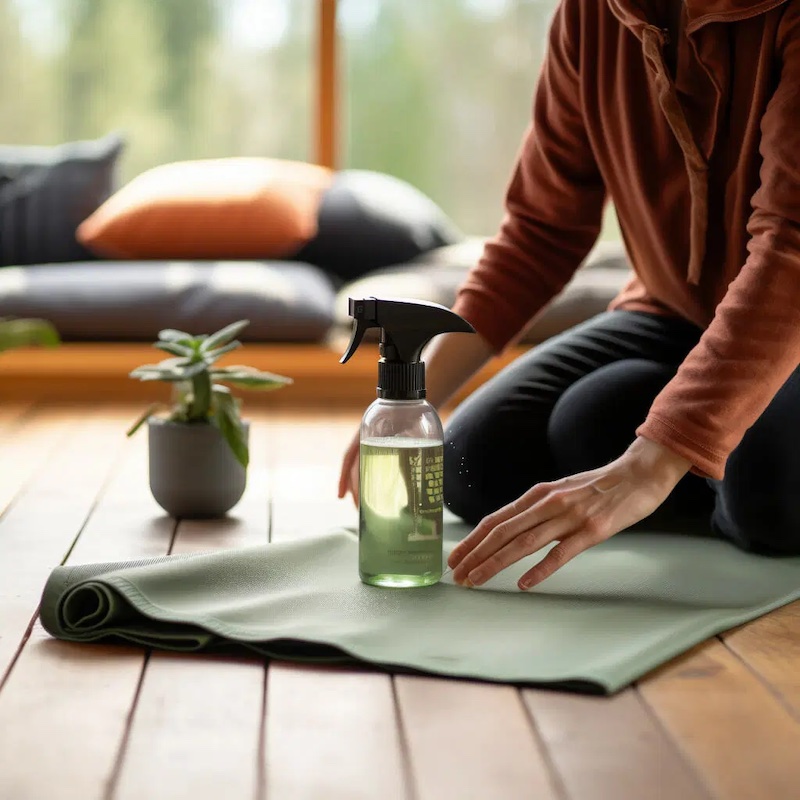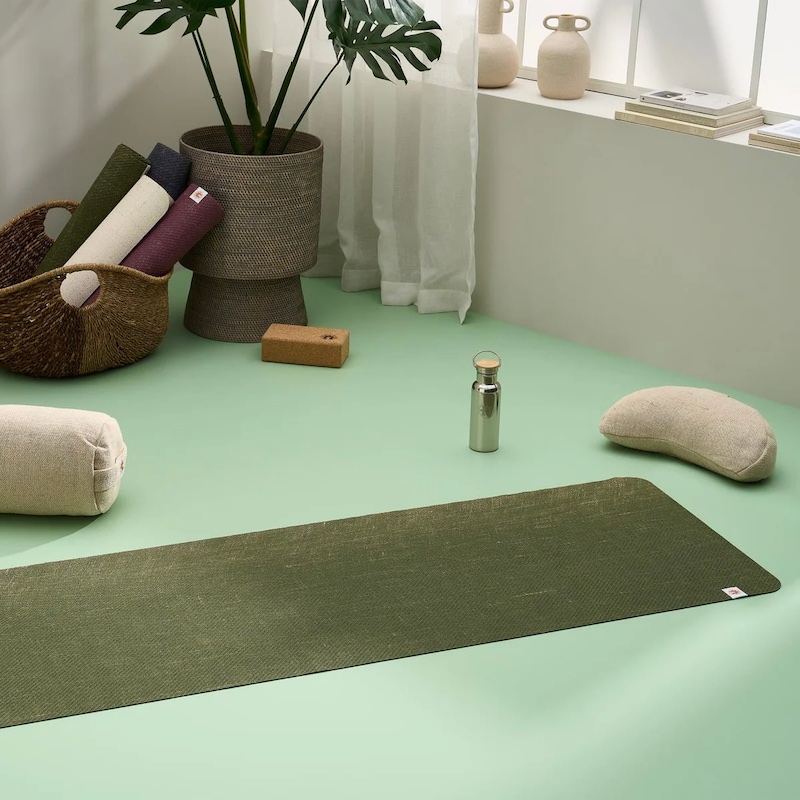Choosing the Right Cleaning Materials
When embarking on the quest for the best way to clean your yoga mat, selecting the right cleaning materials is crucial. Here’s how you can choose materials that are both effective and gentle on your mat.
Natural Cleaning Solutions
Start with simple, natural cleaning solutions. These often home-made mixtures are safe for most yoga mats and the environment. Consider these natural options:
- White vinegar and water: Mix one part vinegar with three parts water for a cleansing solution that’s mild and antibacterial.
- Witch hazel: Use witch hazel with a little water; it’s less acidic but still fights germs.
- Tea tree oil: A drop or two of tea tree oil mixed with water offers powerful antifungal and antibacterial properties.
Incorporate essential oils for a pleasant scent if you like. Just a few drops can add a relaxing fragrance to your mat cleaning routine.
Commercial Yoga Mat Cleaners
If DIY isn’t your style, opt for commercial cleaners designed for yoga mats. Here are a few tips:
- Choose products specified for yoga mat use to avoid damaging your mat.
- Look for “non-toxic” or “eco-friendly” on labels to ensure the cleaner is gentle and safe.
Remember, the best way to clean your yoga mat involves both the right materials and using them correctly. Next, let’s explore how to effectively clean your yoga mat after each practice.
Cleaning Your Yoga Mat After Each Use
The best way to clean your yoga mat involves regular maintenance. Here’s how you can ensure your yoga mat remains fresh and hygienic after each practice session.
- Wipe Down After Use: Gently wipe your yoga mat with a damp cloth after each use. This removes sweat and oils that can break down the material.
- Use a Spray Bottle: Keep a small spray bottle with a cleaning solution handy. Use it to mist the surface of the mat before wiping it down.
- Air Dry Completely: Hang your mat to air dry after wiping it down. Make sure it’s fully dry before rolling it up.
- Avoid Harsh Chemicals: Steer clear of using harsh chemicals for daily cleaning. They can deteriorate the mat’s material.
Following these simple steps ensures that your yoga mat is always ready for your next session. By cleaning your mat regularly, you prevent the buildup of bacteria and odors that can occur over time.
Deep Cleaning Techniques for Yoga Mats
To ensure your yoga mat is deeply cleaned, here are two effective techniques:
The Soaking Method
The soaking method is ideal for a thorough wash. Here’s how to do it:
- Fill a tub with warm water and add a gentle cleaner.
- Submerge your yoga mat fully.
- Let it soak for 5 to 10 minutes.
- Gently scrub the mat with a soft cloth.
- Rinse the mat with clean water to remove any soap residue.
Tips: Use a non-abrasive cleaner. Avoid soaking for too long to prevent damage.
The Washing Machine Method
Not all mats can handle the washing machine. If yours can, follow these steps:
- Place your mat in the washing machine.
- Use a gentle cycle with cold water.
- Add a small amount of mild detergent.
- Run the machine on the delicate cycle.
- Remove the mat immediately after the cycle.
Caution: Check the manufacturer’s instructions before using this method. Air dry after washing.
By using these deep cleaning techniques regularly, you can keep your yoga mat in the best condition.
Drying and Storing Your Yoga Mat
Properly drying and storing your yoga mat is key to its longevity. Here’s what you need to know:
- Dry Thoroughly: After cleaning, make sure your yoga mat is completely dry. Roll it up only when fully dry to prevent mold.
- Keep it Flat: If possible, store your yoga mat flat. This will keep it from getting wrinkles or folds that can affect your practice.
- Avoid Direct Sunlight: Store your mat in a cool, shady place. Direct sunlight can break down the material over time.
- Use a Mat Carrier: For ease and protection, use a yoga mat carrier or bag when not in use.
- Stay Clear of Heat: Keep your mat away from heat sources like radiators, as heat can warp the material.
By following these tips, you ensure the best care for your yoga mat, ensuring it’s ready for your next session.
Maintaining Your Yoga Mat’s Grip and Longevity
Using the right cleaning methods not only keeps your yoga mat clean but also preserves its quality. Careful maintenance ensures good grip and extends the mat’s life. Here are key ways to maintain your mat’s grip and longevity.
- Regular Dusting: Shake off or wipe any loose dust or dirt before and after yoga sessions. This prevents particles from embedding in the mat’s surface, which can reduce grip over time.
- Proper Washing: Use the methods described earlier for deep cleaning without damaging the mat. Harsh scrubbing can wear down the surface and affect grip.
- Timely Cleaning: Clean spills and stains as soon as possible. Delayed cleaning can cause the mat to become sticky or slippery.
- Surface Check: Inspect your mat regularly for any signs of wear or tear. Early detection can help you address issues before they worsen.
- Storage Care: Roll or store your mat lightly without bending or compressing. This practice maintains the mat’s structure and its gripping surface.
By following these steps, you safeguard the functionality and appearance of your yoga mat. The “best way to clean yoga mat” isn’t just about cleanliness. It’s also about making sure it continues to support your practice session after session.
Tips to Avoid Common Cleaning Mistakes
When caring for your yoga mat, it’s easy to make mistakes that can damage it. Here are key tips to steer clear of common cleaning errors:
- Don’t Overuse Water: Too much water can seep into your mat and create a breeding ground for bacteria. Use a damp cloth, not a wet one.
- Avoid Strong Essential Oils: While they might smell nice, concentrated essential oils can break down the mat material. Dilute them well.
- No Harsh Scrubbing: A gentle swipe is all it takes. Rough scrubbing can wear the mat surface and ruin its grip.
- Skip the Bleach: Bleach and other harsh chemicals are a no-go. They can deteriorate the mat, making it unsafe and uncomfortable.
- Beware of Heat: Don’t expose your mat to high temperatures. No radiators, no hot cars, and especially no dryers.
- Don’t Roll it Wet: Rolling a wet mat encourages mold and mildew. Always let it dry fully.
- Steer Clear of Direct Sunlight: Just like heat, direct sunlight can damage the mat. Find a cool, shaded spot for drying.
- Never Store Dirty: Always clean your mat before storing it. This helps prevent lasting stains and odors.
By avoiding these mistakes, you’re on the right path to keeping your yoga mat in the best condition, ensuring the perfect balance between hygiene and durability.
Tips for Maintaining Your Yoga Mat
Here are some tips for maintaining your yoga mat to keep it clean and in good condition:
- Clean your yoga mat regularly: Depending on how often you use your yoga mat, you should clean it at least once a week. This will help remove sweat, dirt, and bacteria that can build up over time.
- Use a gentle cleanser: Avoid harsh chemicals and solvents that can damage the material of your yoga mat. Instead, use a gentle cleanser such as a mix of water and mild soap, or a natural yoga mat spray.
- Hand wash or machine wash: Some yoga mats can be machine washed, while others should only be hand washed. Check the manufacturer’s guidelines for the best way to clean your specific yoga mat.
- Hang to dry: After washing your yoga mat, hang it to dry in a well-ventilated area. Avoid direct sunlight, as this can cause the material to deteriorate over time.
- Store your yoga mat properly: When not in use, roll up your yoga mat and store it in a cool, dry place. Avoid storing it in direct sunlight or extreme temperatures, as this can cause the material to degrade.
- Use a yoga mat towel: If you tend to sweat a lot during your yoga practice, consider using a yoga mat towel on top of your mat to absorb moisture and keep your mat cleaner.
By following these maintenance tips, you can help prolong the life of your yoga mat and keep it in good condition for your practice.



